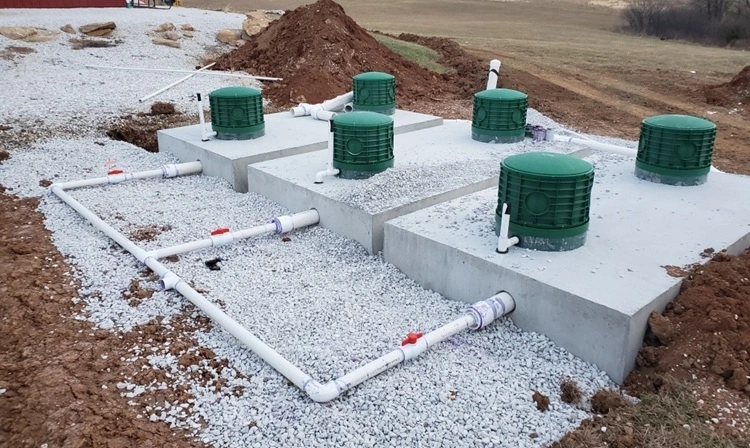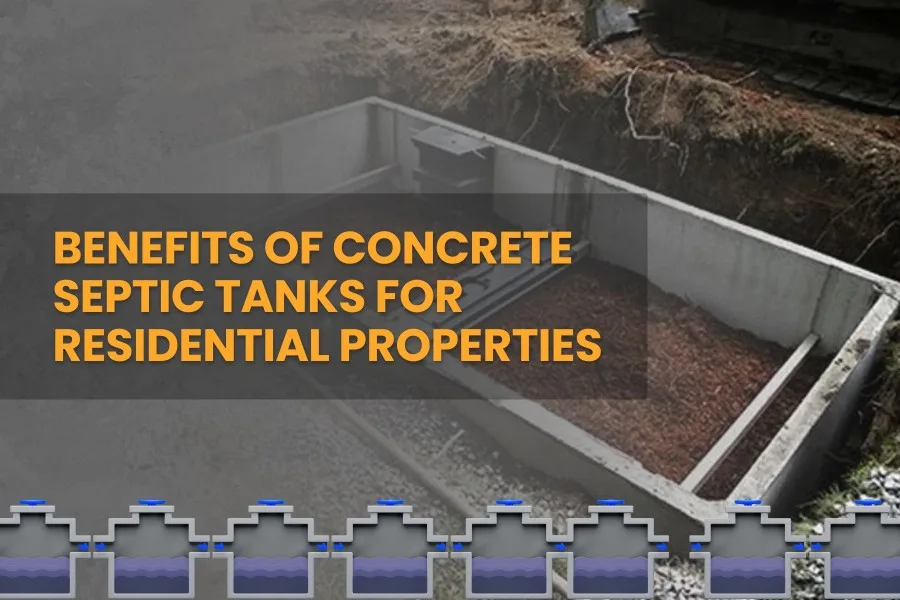Introduction
If you live a rural lifestyle, or in an off grid property, you’re probably aware of some kind of septic system, especially if you don’t have a direct link to a city sewer line.
Septic tanks operate entirely underground. Their function is crucial when it comes to effective and private sanitation. Concrete septic tanks are one of the popular products available for homeowners today for many reasons.
Table of Contents
When building a new home (or replacing an existing system), installing a quality septic tank can save you potential problems down the line and allow your property to function in an environmentally and socially responsible manner.
Let’s explore how septic tanks work, why concrete septic tanks are a reliable and popular choice, and some important things to consider before installing a septic tank.
What Are Septic Tanks?
Septic tanks are underground chambers that treat and manage household wastewater. In locations that are not connected to a municipal sewage line, septic tanks are a practical and reliable alternative to sanitation.
Septic systems are made up of a tank and typically a drain field (also referred to as a leach field).
How Does it Work?
The wastewater from your home empties into the septic tank.
Inside the tank, heavy solids settle out of the wastewater, forming sludge at the bottom or a structure that fits their specifications.
Depending on applicable regulations, the tank can be placed back in the excavation hole and either backfilled with sand, fine texture soil, or gravel as long as the overlain product corresponds with the manufacturer.
Lightweight materials like grease float to the surface, forming the scum layer.
The liquid in the middle, known as effluent, filters to the bottom and is expelled into the drain field where it is further treated through soil filtration and natural microbes.
Not only does this system work, but is effective as well. It treats the wastewater onsite, which reduces the likelihood of surface and groundwater contamination of nearby watercourses and prevents adverse public health issues.

It also provides advantages to water conservation and reuse, where treated water returns safely to the subsurface environment.
That all said, each property may have unique requirements. Homeowners may consider other options, such as Aerated Wastewater Treatment Systems (AWTS), or Leach Drains, depending on site requirements or homeowner choice. But there are concrete septic tanks that will provide you with a reliable and trusted solution.
Types of Residential Septic Tanks
Homeowners usually choose between two primary types of septic tanks; Concrete and Plastic. Let’s talk about the two types:
Concrete & Precast Concrete Tanks
Concrete tanks have been used for decades. They are strong and durable, but are designed to withstand a variety of soil conditions, giving a life expectancy of decades when installed properly.
Precast concrete tanks are rigid tanks that are manufactured in a controlled environment, and lifted into position if there is one, if not, for residential use it is a matter of accurately excavating for your tank that will fit the necessary specs.
These tanks are heavy, which means that they will remain in position regardless of wet or shifting soils. They are less likely to float or move than the lighter versions. So, if you are looking for something that is durable, precast concrete tanks are a good investment (pun intended).
Plastic Septic Tanks
Plastic tanks are lighter and much easier to install, especially in hard-to-reach places. Plastic tanks also won’t corrode in highly acidic or corrosive soils, which is a potential problem for the concrete and a reason to consider a plastic tank as an alternative.
That said, plastic tanks can shift over time, especially in areas with a high groundwater presence. They are not as expensive and easier to transport than a concrete septic tank, but will not be as long-lasting or structurally strong as a concrete septic tank. That said, they can still be a reasonable option in the proper context.
Advantages of Concrete Septic Tanks
There are many advantages to concrete septic tanks that make them a reliable option for homeowners.
1. Strength and Durability
Concrete is SO STRONG. If a concrete septic tank is properly placed, it can last your home for 30 to 40 years, or longer. Concrete will not break down from soil pressure like plastic or metal, or from heavy loads that above-ground vehicles or structures place on it like plastic or metal.
2. Weather Resistance
Concrete tanks will hold up to the harsh conditions from the harsh sun to extreme rain or even flooding. This is what makes them so great for Australia’s different climates.
Concrete tanks are less prone to cracking or shifting due to extreme weather conditions. If you’re betting the safety of your tank during a storm or natural event, then concrete tanks will give you peace of mind.
3. Potential for Long-Term Savings
While it is true that the initial price paid for the concrete tank may be more, the long-term savings are significant. There may not be as much saving once the tank has to be replaced or repaired.
The potential to require fewer interventions can mean concrete tanks are more cost-effective in the long run.
4. Low Maintenance
It is relatively easy to maintain a concrete septic system. With proper utilization and an occasional professional check, it only needs to be pumped out every 3 to 5 years which is a small price to pay for a fundamental part of your home’s sanitation.
The Concrete Used for Making Septic Tanks
Concrete is not concrete when it comes to such an important structure as a septic tank.
For improved strength, water-tightness, and chemical resistance, most manufacturers will augment their concrete using concrete crystalline admixtures, silica fume, as well as superplasticizers.
The reaction of crystalline admixtures with water and cement produces microscopic crystals that fill tiny cracks and advantage the concrete against leaks.

Silica fume is a by-product of silicon manufacturing that is incorporated to enhance durability and density.
Superplasticizers enhance the fluidity of the mix, without increasing the water order, to make concrete more pliable and easy to pour and form, while still providing adequate strength.
These additives allow Modern concrete septic tanks to be not only durable but also resistant to harsh chemicals, aggressive soil environments, and general wear and tear. All factors that improve the performance of septic tanks over time.
Residential septic tank sizes
It is important to determine the proper size of the residential tank. The sizes are determined by consideration of many variable factors, including:
The length of time one person will be in the house.
The amount of water that is expected to be used per day or several times per week.
The regulations Saints area health regulations.
To recover ethen closure of bathwater because of rainwater harvesting.
Across a range of areas, it is believed that:
A tandem in the 1000-litre recommended tanks will function as household sizes, including semi-rural families, for minimal water use.
For families larger than three, tanks from 3000 litres to 5000 litres are much better suited to handle properties and water usage.
In situations where homes have different requirements, such as space, soil condition,s et,c or even perhaps an unusual shape or requirement, then tanks can be manufactured based on”);
Narrative to order” to be customised to suit the particular requirements of the property, ensuring efficiency without compromise.
Maintenance & Cleaning
Even the best septic system will require some love and care from time to time. Here are a few tips to keep your concrete septic tank in good condition:
Professional Inspections
Have someone inspect your concrete septic tank every three years to inspect the system are working well. These inspections can help find problems before they become very costly problems.
Regular Pumping
Have your septic tank pumped out every three to five years depending on your household waste. The pumping will take out the built up sludge so your tank does not block up or overflow.
Everyday practices
Do not flush non-biodegradable products.
Do not clean with strong chemical cleaners as these chemicals will kill the useful bacteria that break down the waste.
Be aware of what you drip down the drains. The most common things to avoid are grease, oil, and food scraps. All of these will build up and block the drains.
If you take care of your concrete septic tank you should expect to be able to use it for 30 years or more (as long as you maintain it regularly). Regular maintenance is the most important for guaranteeing a long life.
Government Requirements for Residential Septic Tanks
Residential septic systems in Australia need to adhere to strict government regulations and standards for very good reasons. These regulations are in place to protect the health of both people and the local environment.
Each state or territory will have its own set of regulations and/or standards. Here are some key points:
- Ensure that septic systems have been installed by licensed people.
- Obtaining approvals from local councils or environmental authorities.
- Regularly servicing the system to ensure compliance.
As an example, in New South Wales (NSW) septic tank systems must have appropriate accreditation from local sewage management policies.
If a septic tank does not conform to these policies, penalties can be imposed, and of course, there are the ramifications if our water supply or local environment is negatively impacted.
Before the installation of a septic tank system, you should refer to your local council’s requirements. This would be the most appropriate way to comply with legal requirements, operate safely, and get the system working as intended.
Conclusion
When managing domestic wastewater and septic systems there is very little that beats concrete septic tanks when there is no sewer system available.
They are strong, durable, environmentally advantageous and quite often low maintenance. If a septic tank system is installed correctly, constructed from the best materials ie crystalline admixtures, silica fume, superplasticizers; and serviced as necessary, they will endure for many years.
If you are building a new house, local council or environmental authority requirements should be in place for a be a compliant septic tank.
For those of you living with an outdated septic system, consider investing in a concrete septic tank system which will have protection for potentially your property, health and environment.
Sagar Telrandhe is a Construction Engineer with a B.Tech in Construction Engineering & Management. Passionate about infrastructure development, project planning, and sustainable construction, he specializes in modern construction techniques, project execution, and quality management, contributing to efficient and innovative building.


